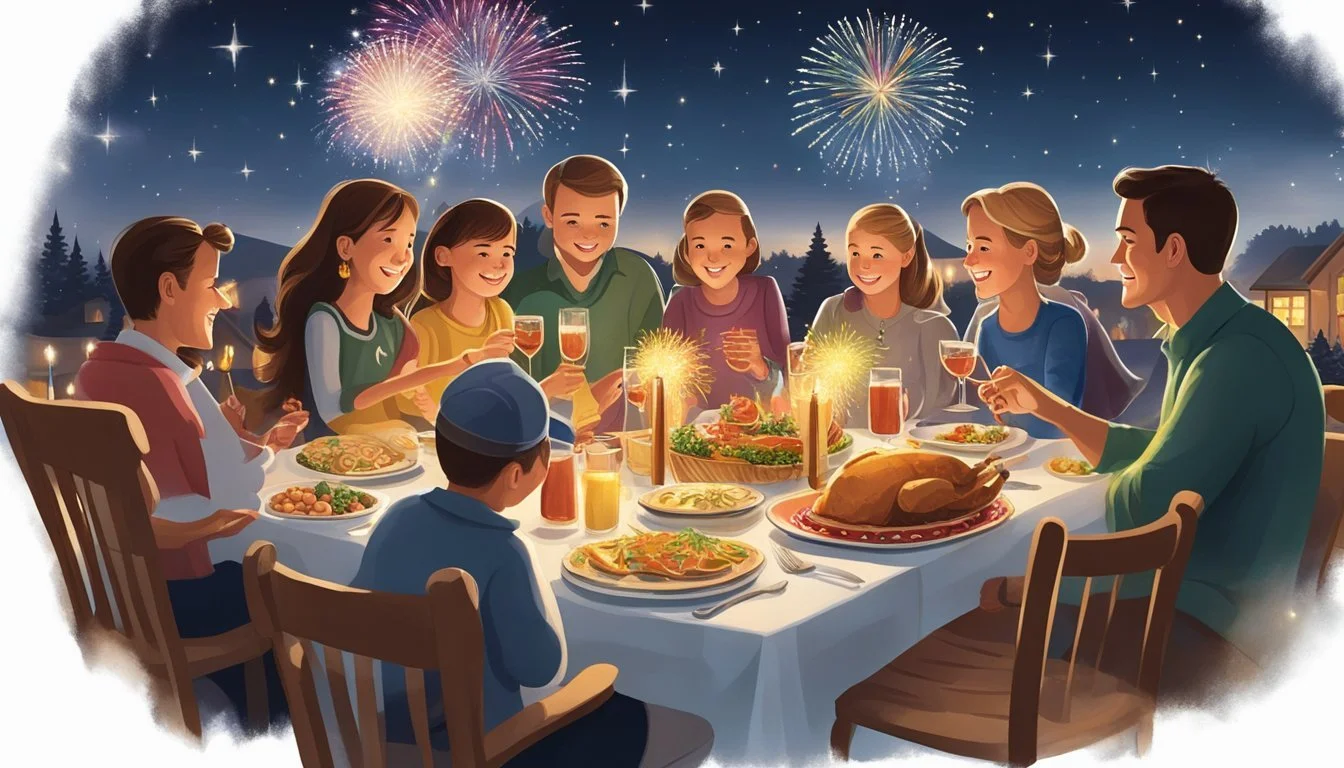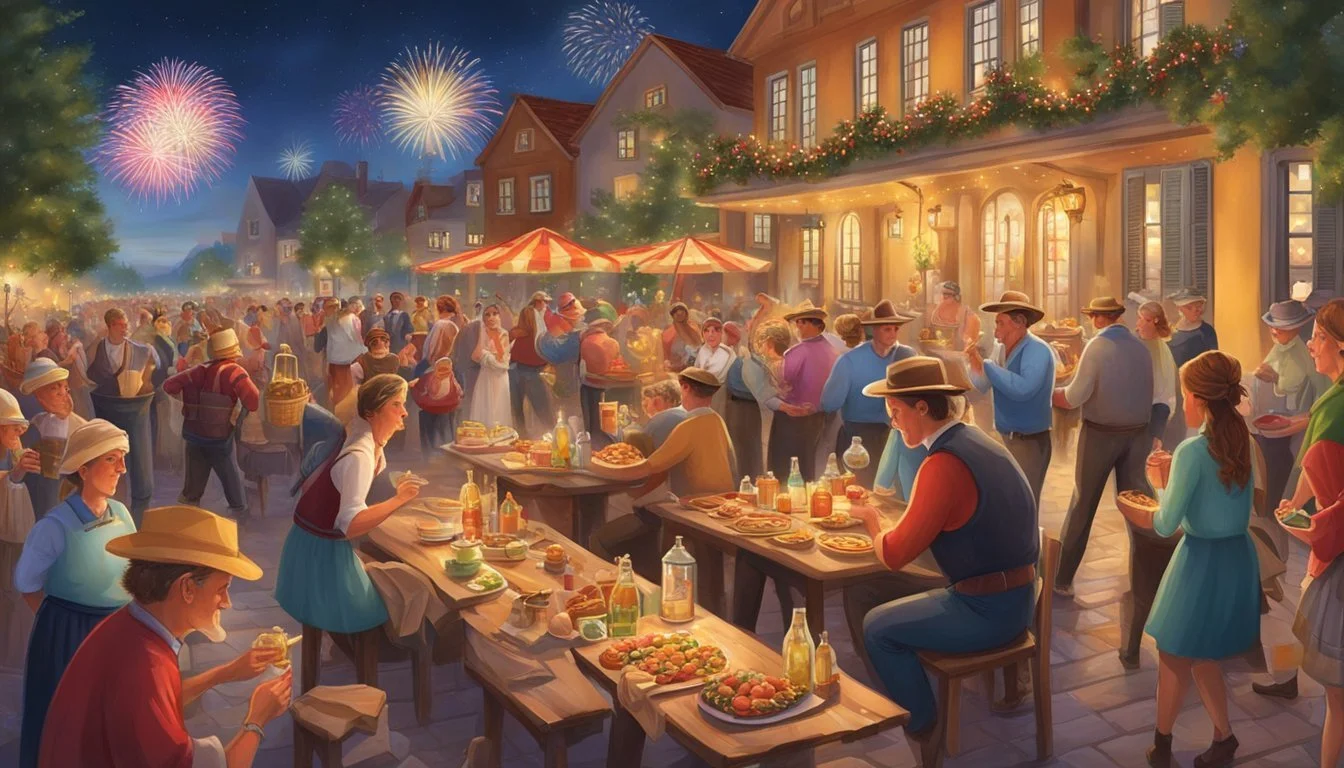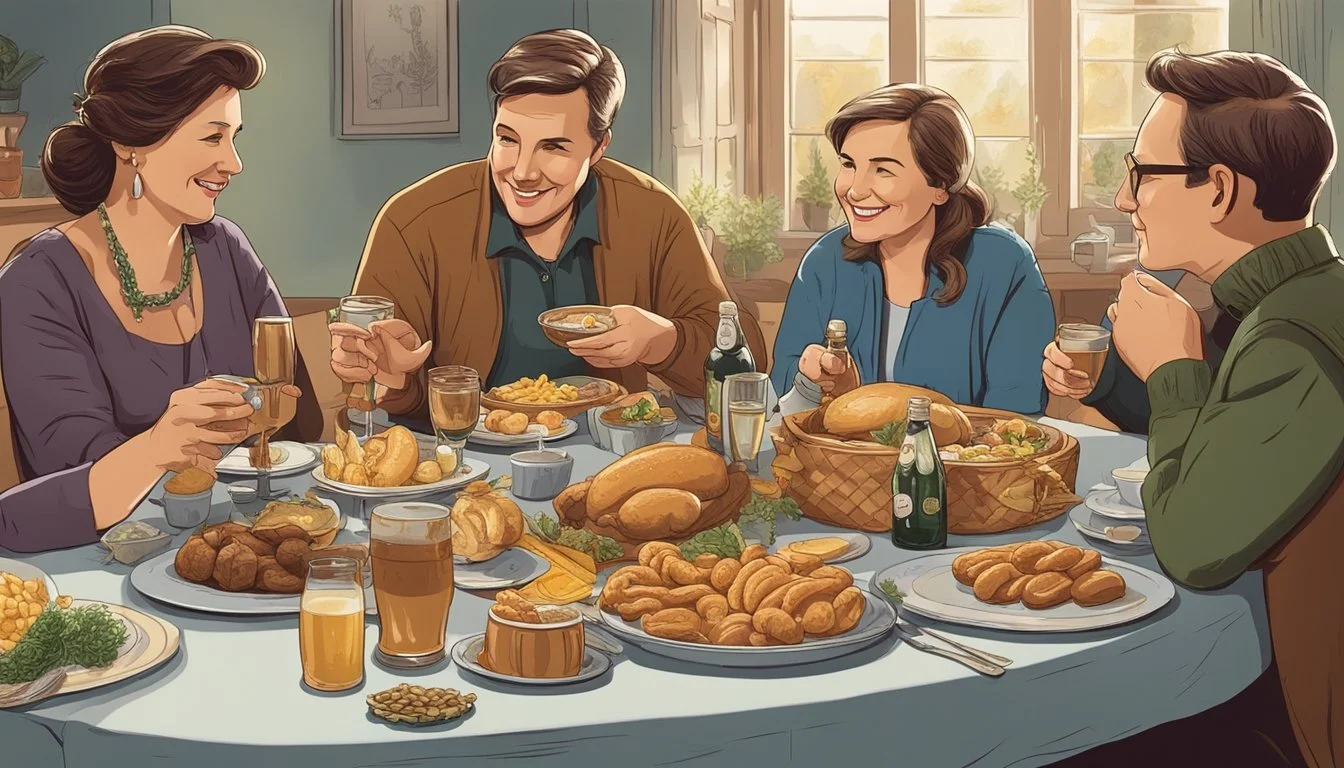German Texan Traditions for Silvester
Celebrating New Year's Eve with a Cultural Twist
Silvester, the German name for New Year's Eve, is celebrated with a host of traditions that combine both cultural heritage and festive merriment. This event, which marks the close of the old year and the ushering in of the new, holds a special place in the hearts of German Texans. These communities have managed to preserve a unique blend of customs brought from their German forebears and adapted to the Texan cultural landscape.
Among the traditions that German Texans partake in is the practice of Bleigiessen, a form of fortune-telling using molten lead or tin. Participants pour the heated metal into water and then interpret the resulting shapes to predict what the coming year might hold. This charming custom, coupled with the typical revelry of food, drink, and dance, highlights the fusion of German heritage with Texan conviviality.
As the clock nears midnight on Silvester, German Texans often partake in sharing stories, toasts to good health, and resolutions for the New Year. These collective acts of looking forward are testament to both the solemnity and celebration that New Year's Eve encapsulates within the German Texan community, bridging the old world with the new in festive harmony.
Historical Origins of Silvester Traditions
Silvester traditions in Germany are deeply rooted in historical figures and ancient customs. These traditions blend religious significance with cultural practices that date back to Roman and Germanic times.
Silvester and Pope Sylvester I
Pope Sylvester I, who served as pontiff from 314 to 335 A.D., is a central figure in the traditions of Silvester. His death on December 31st, 335 A.D., marked the basis for the alignment of his feast day with New Year's Eve. Legends associated with Sylvester I involve his relationship with Emperor Constantine. Among the noteworthy legends, Sylvester I was said to have cured Constantine of leprosy, which ultimately led to the emperor's baptism. The Basilica of St. John Lateran, to which Sylvester contributed, became one of the most important churches in Christendom, rivaling even St. Peter's in significance.
Date of Death: December 31, 335 A.D.
Legend: Sylvester I cured Constantine of leprosy
Contribution: Basilica of St. John Lateran
Another key aspect of this association is the transformation of these religious events into the secular celebration of the New Year in Germany, especially in regions with a strong historical German influence.
Influence of Roman and Germanic Customs
The blending of Roman and Germanic customs shaped how Silvester is celebrated. In ancient Rome, the New Year was a time for feasting and jubilation, a practice that persisted even after the rise of Christianity. Over time, Germanic tribes incorporated elements of Roman culture into their own traditions, leading to a unique hybrid of celebration styles.
Germanic Traditions:
Feasting
Merrymaking
Symbolic rituals (e.g., lead-pouring, known as "Bleigiessen")
The eventual adoption by the German peoples of Silvester includes elements like noise-making to ward off evil spirits—echoing the Roman tradition of raucous celebration—and other localized customs that vary from one region to another, including Berlin and areas with a significant population of German heritage.
The historical tapestry of Silvester traditions reveals an intricate blend of homage to a revered pope and the integration of a multicultural heritage of festivities that make up the modern-day observance of New Year's Eve in Germany.
Traditional Silvester Celebrations in Germany
When it comes to Silvester, Germany showcases a vibrant mix of time-honored traditions and lively celebrations, particularly prominent in Berlin. From a grand display of fireworks to the culinary delights that adorn German tables, each aspect of the festivities reflects a cultural richness that both locals and visitors eagerly anticipate as the year draws to a close.
New Year's Eve in Berlin
In Berlin, the heart of Germany's New Year's Eve, or Silvester, beats at the Brandenburg Gate, which serves as the focal point for grandiose celebrations attended by hundreds of thousands of people. The night sky is illuminated by fireworks as the clock strikes midnight, marking the beginning of the new year. This dazzling display is a central component of the celebrations, with spectators gathering from all over the city and beyond to experience the spectacle.
Customary Foods and Beverages
Silvester would not be complete without the traditional foods and beverages that signify good fortune and cheer. Among the most popular are:
Sauerkraut: Believed to bring blessings and wealth for the new year.
Pfannkuchen, also known as Berliner Pfannkuchen: These stuffed doughnuts are a sweet treat, often filled with jam and dusted with sugar.
Carp: A fish that is customarily served at the Silvester dinner, sometimes with a scale kept as a lucky charm.
Sekt or Champagne: Toasting to the new year with sparkling wine is a must.
To symbolize prosperity, small gifts like marzipan in the shape of a horseshoe or pig are exchanged, and a quirky tradition involves watching "Dinner for One," a British stage sketch that has become a New Year's Eve TV classic in Germany. Some even carry a miniature wallet to ensure a year filled with financial success.
Good Luck Charms and Superstitions
In German Texan traditions for Silvester, various good luck charms and practices of fortune-telling are observed with enthusiasm. They hold the promise of prosperity and good fortune for the upcoming year.
Bleigießen and Fortune-Telling
Bleigießen, or lead pouring, is a traditional Silvester activity. Participants melt small pieces of lead to pour into cold water, forming shapes which are then interpreted to predict the future. Each shape is believed to symbolize certain outcomes for the next year. For instance, a bubbly surface might indicate money is coming, while a cross could signify obstacles.
Bubble: Money
Cross: Obstacles
Symbols of Luck and Fortune
Other ubiquitous symbols of luck in German Texan celebrations include:
Horseshoe: Often hung over doorways to invite good fortune into the home.
Pig: Recognized as a token of prosperity and abundance, pigs might be presented in the form of marzipan sweets.
Clover: Particularly one with four leaves is regarded as a lucky charm, promising good luck.
Marzipan: Shaped into lucky symbols like pigs and clovers, these sweets are both treats and talismans.
These symbols and rituals form a central part of the heritage and help shape a hopeful outlook for the year to come.
Welcoming the New Year with Common Phrases
As Silvester approaches, German Texans embrace a fusion of traditional German greetings with American enthusiasm. They commonly exchange New Year’s wishes, blending cultures through language.
Among the phrases, "Prost Neujahr!" resonates with cheer, translating directly as "Cheers to the New Year!" This toast often accompanies raised glasses as the clock strikes midnight. The clinking of glasses symbolizes a collective hope for prosperity and joy in the upcoming year.
"Guten Rutsch" is another prevalent expression, which literally means "Good slide." It carries the sentiment of sliding smoothly into the new year. This saying is especially popular before the New Year officially begins, illustrating the transitional nature of Silvester.
The full phrase "Einen guten Rutsch ins neue Jahr!" is an extension of the above, wishing someone a good start to the new year. The benevolent intention is conveyed in the addition of "Einen," effectively wishing the other person directly.
On a softer note, "Frohes neues Jahr" offers a heartfelt "Happy New Year" to friends and family. It's synonymous with affection and camaraderie, highlighting good wishes for the year ahead.
Finally, "Prosit Neujahr!" serves a similar purpose to "Prost Neujahr," with "Prosit" being another form of toast. It embodies a sense of formality and tradition, encapsulating the essence of the moment when one year gives way to another.
Phrase Translation Usage Context Prost Neujahr! Cheers to the New Year! As midnight strikes Guten Rutsch Good slide Before the new year begins Einen guten Rutsch ins neue Jahr! A good start to the new year Same as "Guten Rutsch" with direct wish Frohes neues Jahr Happy New Year After midnight has passed Prosit Neujahr! A toast to the New Year Formal New Year's gesture
German Texans participate in this linguistic ritual with authenticity and warmth, carrying the spirit of Silvester into the New Year.
Contemporary Celebrations and Entertainment
Silvester in Germany combines vibrant public celebrations with traditional entertainment. Fireworks illuminate the skies, while an iconic British comedy sketch is essential viewing in households and parties.
Fireworks and Public Gatherings
Germans welcome the New Year with spectacular fireworks displays. The skies over cities and towns are filled with colors and lights as people come together to celebrate. One of the most notable gatherings takes place at the Brandenburg Gate in Berlin. Thousands congregate at this historic site for one of the largest New Year's Eve parties in Germany, featuring live music, shows, and a midnight fireworks display.
Watch 'Dinner for One' Comedy Sketch
A unique tradition involves the annual viewing of "Dinner for One," an English-language comedy sketch that has become a New Year's Eve ritual. Almost every German television channel airs this short film, which holds the Guinness World Record as the most frequently repeated TV program ever. The catchphrase "The same procedure as every year" has entered the German lexicon, encapsulating the nostalgic repetition of Silvester celebrations.
New Year's Resolutions and Future Outlook
German Texans observe Silvester, New Year’s Eve, with a tradition-steeped nod to both the past and the future. On this night, a zeitgeist of new beginnings permeates the community as individuals set resolutions for the year ahead. These resolutions often focus on personal growth, health, and aspirations, reflecting a collective anticipation for positive change.
The practice of making resolutions mirrors a global trend to seize the New Year as an opportunity for self-improvement. German Texans may write down their goals or share them with friends and family, solidifying their intentions for the coming year.
Health goals such as improving diet or increasing exercise
Personal growth objectives like learning a new skill or reading more
Professional resolutions to enhance careers or achieve better work-life balance
Furthermore, many German Texans engage in rituals to predict fortune and future prospects. Analogous to Bleigießen—a customary practice in Germany which involves interpreting shapes formed by molten lead cooled in water—German Texans may opt for safer methods like using wax.
The future outlook among this group remains a point of focus, with community members reflecting on the past year’s lessons to inform their decisions moving forward. It is a time for recalibration, strengthening social bonds, and fostering optimism for what the future holds. The jovial atmosphere and hopeful dialogues encapsulate the cultural significance of Silvester, where every individual stands poised on the cusp of a new personal era.
Conclusion
German Texans honor their heritage by incorporating a blend of traditional German customs and local Texan influences during their Silvester (New Year's Eve) celebrations. Festivities often include family gatherings, where a sense of communal spirit and anticipation for the year ahead prevails.
They commonly enjoy a feast that marries German delicacies with Texan favorites, creating a unique culinary experience. Music and dancing are also integral, pulling from both German folk tunes and country notes synonymous with the Lone Star State.
The ritual of Bleigiessen—the practice of melting lead and interpreting its solidified shapes to predict the future—is a cherished tradition among German Texans. Although this custom is rooted in Germany, it manifests with a local twist, as predictions often reflect the hopes and aspirations germane to life in Texas.
German Texans remain true to their roots through such customs, yet they seamlessly adapt these to their Texan identity, ensuring the celebrations resonate with the diverse tapestry of cultures within the state. They look forward to the coming year with a mix of reverence for their lineage and an embrace of their present Texan community.
The synergy of these traditions during Silvester underscores the enduring legacy and adaptability of the German Texan community—they honor the past while celebrating the present and looking forward to a prosperous new year.







